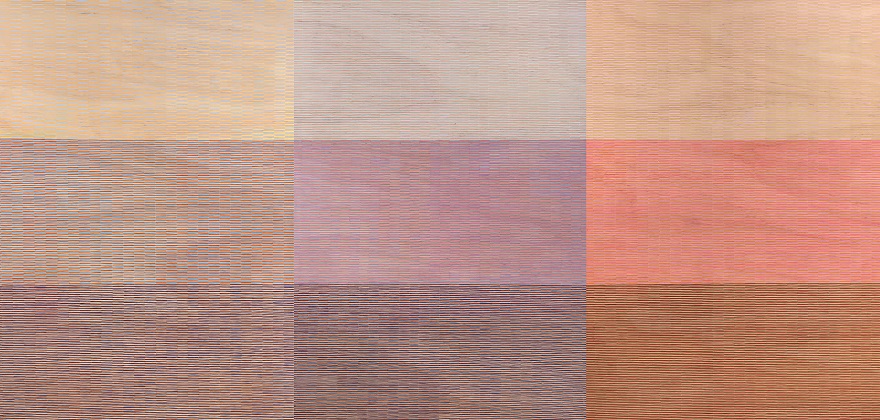Review: Evelyn Kotai, “Breathing Pattern”
Art Gallery of Western Australia
Review by Lydia Edwards ⋅
“Breathing Pattern” is tucked away in a corner of the ground floor of the Art Gallery of Western Australia, and it took me a moment to locate it. I soon realised, though, that this peaceful placement is more than appropriate for the aim of Eveline Kotai’s work. As she eloquently puts it, “We don’t have space in our lives. It’s getting harder and harder to find space … I want in my exhibition to achieve ‘a moment between two thoughts … it’d be nice if I could achieve that’.”
This is certainly accomplished with the exhibition’s biggest and most imposing piece, Living Forest (detail pictured top), which takes the viewer on a trajectory of the seasons with bold colour and confident lines. As you meander down the length of the canvas, the lines gradually thin out into an emptier space, threaded with elegant autumnal patches of colour. Reach the end and these have vanished, the lines now muted and fading into winter. The sense is that the work has stopped short just before a void, and other pieces – White Noise Remix amongst them – continue that theme of neutral shades, a calmer or lonelier space (depending on your interpretation) sometimes interrupted with tiny splashes of colour that are shown either in a dot of paint or dash of pen and take the viewer by surprise.

acrylic, canvas and nylon thread on linen; 91 x 91 cm, Courtesy of Artist and Art Collective WA.
Kotai’s method is intertextual and interdisciplinary. Described as “idiosyncratic” by Art Collective WA, part of her technique involves cutting up paintings into slim strips and rearranging them across a new surface, with each piece attached using a sewing machine and invisible thread. This process recalls deconstruction and raises connotations of regeneration and transmutation, but appears meticulously planned – perhaps even obsessive. Kotai acknowledges this, describing her practice as labour-intensive but, for her, calming and therapeutic in its repetitiveness. It helps her to spend time in the moment and it is this gift that she fervently wishes to pass on to her audience.
To some extent this could be compromised by the artist’s statement, which prompts visitors to enter neutrally, suppressing an ingrained and perhaps conditioned desire to search for deep meaning in the works. As Kotai poignantly remarks, “a reliance on text … caus[es] a crisis of confidence … we are now in the habit of going straight to the didactic before looking at the work, not trusting our own ability to see … It’s always a relief to me when it just states the name, title, date and medium”. In common with practitioners like Yoko Ono, who famously remarked that artists are used to controlling how much the audience “takes”, Kotai’s statement makes us aware of how damaging and demoralising this endless power play and contextualising can be, not just for the viewer but for the artist too. Because of this, it is surprising that the works’ titles are sufficiently enigmatic to invite speculation. Key examples are Trace Elements Expanding, Writing on Air and the show’s title work Breathing Pattern. These works hold beautiful titles that are hard to dismiss without examining further.

The work Breathing Pattern embodies another approach favoured by Kotai, that of using acrylic on plywood to produce what, from a distance, appears to be a set of blocks akin to the work of Mark Rothko or Sean Scully. Close up, we can see they are composed of tiny meticulous lines of paint, leaving just enough space and transparency to reveal a shadow of the wood grain skeleton beneath.
As with Rothko and Scully, along with Kazimir Malevich’s famous white and black canvases, first glances belie the depth and intensity of tone and texture. Perhaps this complexity and variety of technique is what Kotai wishes us to focus on, and wants us to let speak for itself. A lack of supplementary text in an exhibition can sometimes cause an audience to panic. It can impose expectations that threaten to move art back into the ivory tower.
The faith Kotai puts in her audience is heartening, and her encouraging plea to “trust our own ability to see, our own desire to make what we can of the artists’ intent” allows the exhibition to be an accessible, communicative and collaborative space. Breathing Pattern gave me permission to take my time with the works, to discuss or to muse silently, to analyse or to internalise.
I think Kotai would be pleased with that.
Eveline Kotai: “Breathing Pattern” runs until 10 February, 2020.
Pictured top: Eveline Kotai, ‘Living Forest’, 2019 (detail); acrylic, giclee print, belgian 76 x 1200 cm; Courtesy of Artist and Art Collective WA.
Like what you're reading? Support Seesaw.






